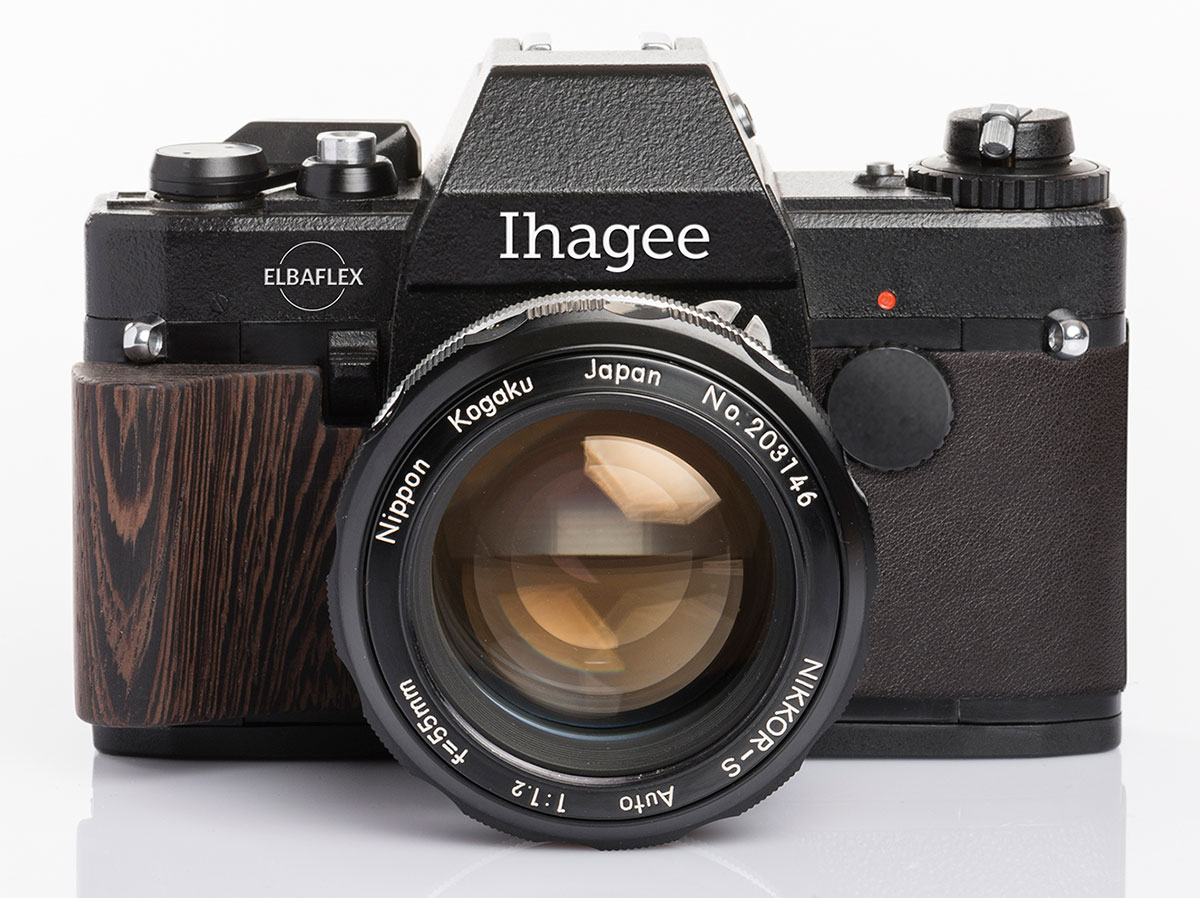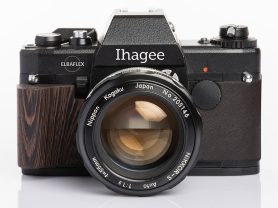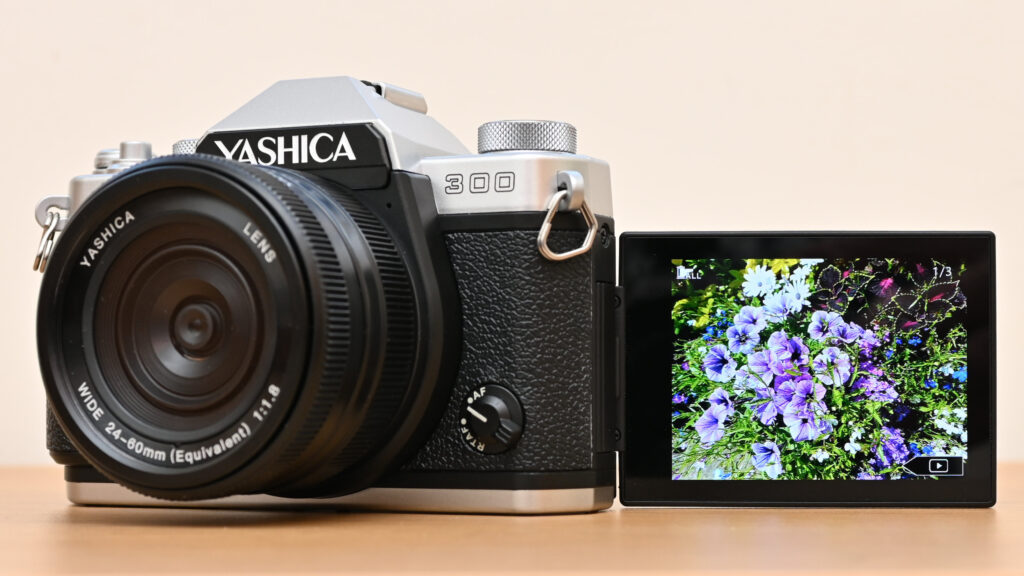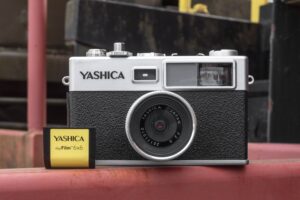
With my recent review of the underwhelming Yashica digiFilm camera Y35, I started to wonder about the fate of some of the other crowdfunded cameras I remember reading about over the years. While the Yashica digiFilm camera Y35 was funded, released, and technically did everything that the creators promised it would do, most people saw the camera as a failure. Was that the fault of its creators, or were people unable to control their own expectations of what a retro digital camera was capable of?
While there have been a huge number of crowdfunded photography products out there, I limited myself to just cameras, and decided to take a look at a couple which I thought were the most interesting.
Ihagee Elbaflex
A common theme of nearly every crowdfunded film project is some kind of “badge engineering” of a once respected photography brand. In every case this is done, the brands associated with these modern day projects have absolutely no historical lineage to the original brand names they are using. Case in point is the Ihagee Elbaflex.
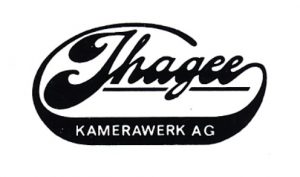 The name Ihagee dates back to 1912 when Dutch immigrant Johan Steenbergen started his own company in the area of Dresden, Germany. Steenbergen was a keen businessman with an interest in photography, and many of Ihagee’s earliest products were high quality folding and SLR cameras. The company made a large number of models in its first two decades of existence, but in 1932 a new camera called the Ihagee Exakta started production. A Single Lens Reflex design which used 127 format roll film, the Exakta was unlike anything the world had seen before. The first miniature SLR camera, the Exakta had an interchangeable lens mount, focal plane shutter with a fast 1/1000 top shutter speed, and supported a wide range of Germany’s finest lenses.
The name Ihagee dates back to 1912 when Dutch immigrant Johan Steenbergen started his own company in the area of Dresden, Germany. Steenbergen was a keen businessman with an interest in photography, and many of Ihagee’s earliest products were high quality folding and SLR cameras. The company made a large number of models in its first two decades of existence, but in 1932 a new camera called the Ihagee Exakta started production. A Single Lens Reflex design which used 127 format roll film, the Exakta was unlike anything the world had seen before. The first miniature SLR camera, the Exakta had an interchangeable lens mount, focal plane shutter with a fast 1/1000 top shutter speed, and supported a wide range of Germany’s finest lenses.
The Ihagee Exakta was a successful camera, but in 1936, the company pivoted and made a version of the Exakta which used double perforated 35mm film. At the time, this film was often associated with cinema cameras and was often referred to as “Kine” or cinema film, so to differentiate from the earlier roll film Exaktas and the new 35mm models, the new cameras were referred to as Kine Exaktas.
The Kine Exakta retained all that was great about the original Exakta, but was smaller, more convenient to use, and had more features. The Exakta was an enormous success and would remain in production until the very early 1970s as one of the most successful 35mm SLRs ever made.
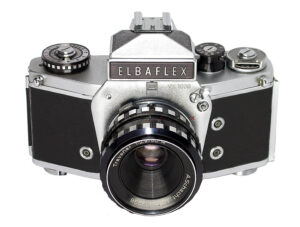
In 1967, a version of the Exakta VX1000 was rebranded as the Elbaflex in some European countries in which the Exakta name couldn’t be used. These cameras are otherwise identical to their Exakta counterparts.
By the 1970s, the Exakta name and company had been fully incorporated into the East German conglomerate, VEB Pentacon, and by the 1980s, the name and brand fell out of use. Its fate remained unknown for several decades until 2017 when a new company, going by the name Ihagee was said to have been created by ex Leica and Schneider employees teased the world with an all new camera. In November of that year, the proposed new camera, jointly designed by German and Ukrainian engineers was announced called the Ihagee Elbaflex.
The new camera set a modest funding goal of $50,000 but was never able to reach it. Behind the project was an attractive camera with a black body, vertically travelling metal blade focal plane shutter, and a Nikon F lens mount. The Elbaflex was promised in two trim levels, the Elbaflex Base and Elbaflex Prime. The differences were cosmetic, with the Prime version having an attractive wooden hand grip, real leather body covering, a five year warranty (up from two) and supposedly better build quality.
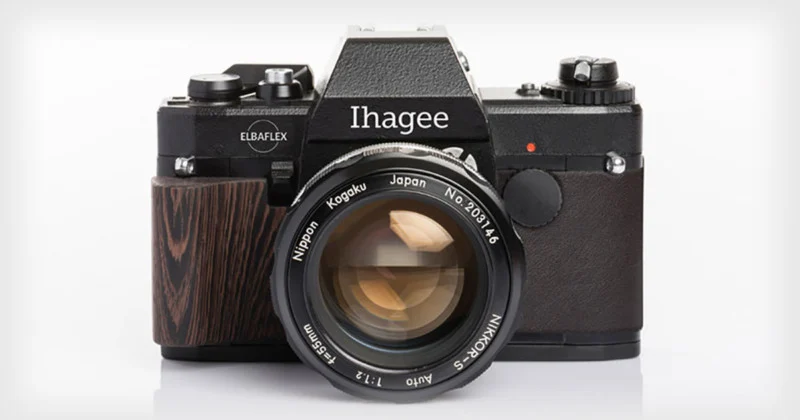 The new Ihagee Elbaflex was an attractive camera that looked surprisingly complete for something so early in the funding process. As people began to pour over its specs and images posted online, it started to look familiar to some people. Connecting the dots as having been designed by Ukrainian engineers, keen eyed collectors correctly noticed a striking similarity to a Soviet-era Ukrainian built camera called the Kiev 19M which began production in 1988.
The new Ihagee Elbaflex was an attractive camera that looked surprisingly complete for something so early in the funding process. As people began to pour over its specs and images posted online, it started to look familiar to some people. Connecting the dots as having been designed by Ukrainian engineers, keen eyed collectors correctly noticed a striking similarity to a Soviet-era Ukrainian built camera called the Kiev 19M which began production in 1988.
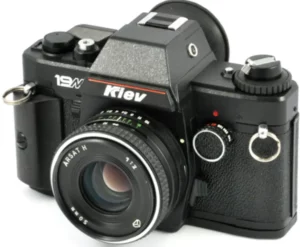
Like the Elbaflex, the Kiev 19M had a vertically traveling metal blade focal plane shutter, and used the Nikon F mount. The physical layout of the controls and all of its various bumps and cosmetic details were the same. It was almost as if this new German and Ukrainian iteration of Ihagee was taking the Kiev 19M, slapping a new logo on it and calling it a day!
As the days and months started to pass, it became more and more clear that is exactly what happened. What wasn’t entirely clear though, was whether or not the new Elbaflex was new construction using the same design as the 1980s camera, or if these were new old stock cameras found in a warehouse that were given a new name. If the Kiev 19M had been made in any country other than the Soviet Union, this would seem implausible but with rumored warehouses of unused Soviet cameras, lenses, and nixie tubes laying around for decades, it certainly was possible.
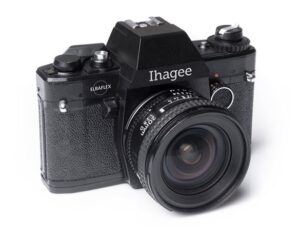
Assuming that the new Elbaflex was going to be a brand new camera, made with modern electronics and tooling, there was a lot to like about the camera. For as little as $299, buyers could secure an Elbaflex Base without a lens, and adapt it to one of millions of Nikon F mount lenses out there. Effectively like a brand new Nikkormat, the price wasn’t unreasonable.
Yet, as quickly as it had been announced, the Elbaflex missed its goal and seemingly disappeared off everyone’s radar. As of July 2025, the original Kickstarter page still exists, but had has no updates since December 4, 2017. It is not unusual for crowdfunded projects to miss targets, but often, the creators will come back with a revised goal or try again at some point in the future and that never seemed to happen with this camera.
A Kosmo Foto post from September 2018 shed more light on the failure, stating that the company behind the camera, Net SE, had filed for bankruptcy, after the company’s CEO was injured in a bad car accident and was not able to advance the company, or any of the other ambitious projects it had proposed.
What Went Wrong?
The ultimate fate of the Ihagee Elbaflex is pretty straightforward. A lack of interest from the crowdfunding community and the bankruptcy of the company doomed it. The Elbaflex failed for both reasons and in the ashes of the company who was behind it, no one picked up the torch to continue its journey.
What is interesting to me, is that of all the crowdfunded cameras that I researched for this article, the Ihagee Elbaflex is the only one that had a real shot of not only being produced, but also meeting everyone’s expectations since it was based on a camera that actually exists. Had the camera been released, people would have already known what to expect as the Kiev 19M was a proven design.
I doubt that there is a warehouse somewhere of unused Kiev 19Ms just waiting to be rebadged, but I don’t think its a stretch to think that some Ukrainian manufacturer couldn’t revise this camera’s design (or one similar) and produce new copies again. Maybe it wouldn’t have the name Ihagee Elbaflex, but it seems reasonable that it could be done, yet it hasn’t.
Reflex Modular Camera
If the idea of a camera like the Ihagee Elbaflex which was a basic, no frills mechanical camera based off a Soviet-era design and rebuilt in the 21st century wasn’t interesting to you, perhaps the exact opposite might be.
In September 2017, a second crowdfunded 35mm SLR started generating headlines. Unlike the Elbaflex, this camera was a completely new, fully modular design, simply called the Reflex.
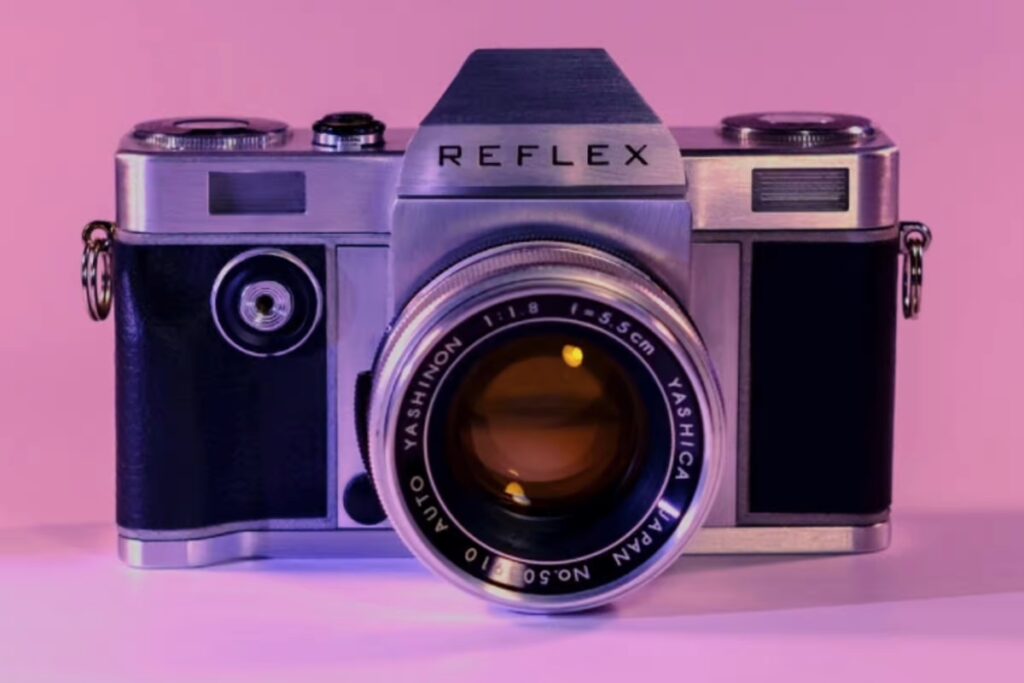 The Reflex was created by a man named Laurence Von Thomas and took the concept of a 35mm SLR and made it universally interchangeable. Instead of a traditional lens mount, it would feature something called the “I-Plate” which was an “interchangeable interchangeable lens mount”. The camera itself could swap out its lens mount, giving it compatibility with nearly any 35mm SLR lens ever made, from M42, to Canon FD, to Nikon F, and others. Further, the back of the camera was interchangeable too, allowing for film magazines similar to cameras like the Kodak Ektra, Adox 300, and Zeiss-Ikon Contarex, allowing a photographer to hot-swap rolls of film mid-roll, without wasting an exposure.
The Reflex was created by a man named Laurence Von Thomas and took the concept of a 35mm SLR and made it universally interchangeable. Instead of a traditional lens mount, it would feature something called the “I-Plate” which was an “interchangeable interchangeable lens mount”. The camera itself could swap out its lens mount, giving it compatibility with nearly any 35mm SLR lens ever made, from M42, to Canon FD, to Nikon F, and others. Further, the back of the camera was interchangeable too, allowing for film magazines similar to cameras like the Kodak Ektra, Adox 300, and Zeiss-Ikon Contarex, allowing a photographer to hot-swap rolls of film mid-roll, without wasting an exposure.
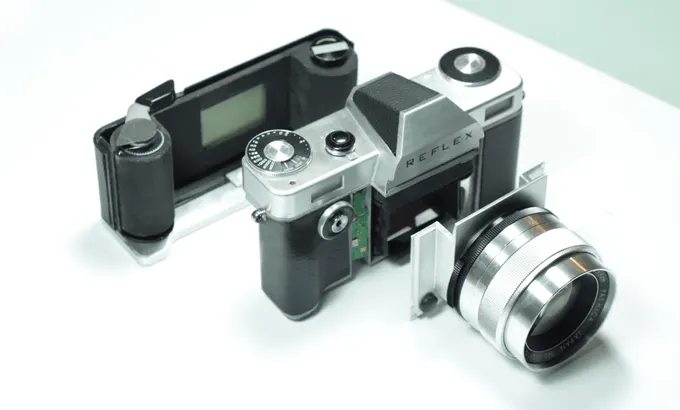
If that wasn’t exciting enough, the Reflex also boasted an in body flash, a constant LED light, aperture priority automatic exposure, a focal plane shutter with speeds up to 1/4000 and a tiny computer called an Arduino which gave it smartphone connectivity.
Unlike the Elblaflex, the ambitious feature set of the Reflex excited a great deal of backers, and the project was fully funded as of December 2017 with a promised release date of August 2018. After reaching its initial goal, a stretch goal of £150,000 was added to add smartphone capability using the onboard Arduino computer.
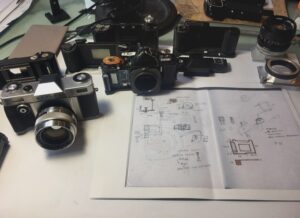
Things seemed to be looking up for the Reflex camera, but that’s where things went awry. Shortly after a promising post from the camera’s creator in January, the company fell silent when another update was posted suggesting that securing manufacturing was an ongoing struggle. The creators were still optimistic that finished prototypes would be ready by May/June of that year, however.
A post on July 15, 2018 delivered news that everyone expected, which was that prototypes were not yet ready, and hitting the company’s original August 2018 date was no longer realistic. A great deal of information about production struggles of such an ambitious project understandably slowed production of a viable camera. Updates on retail prices of the finished camera were announced, as was a promise to have something to show at Photokina in September, which I’ll save you the suspense, never happened.
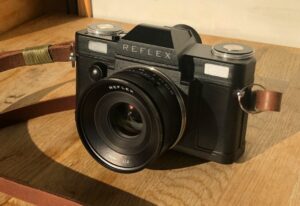
I could continue to summarize the timeline of events that happened next, but you can still read all of the company’s press releases on the Reflex’s Kickstarter Updates page. Fast forwarding to August 2019, the team announced that a new shutter had to be developed along with a more powerful processor and larger battery, which required a chassis redesign, resulting in what the company called the Reflex II. A mock up of a black bodied Reflex was featured, and it was announced that working prototypes should be available by October.
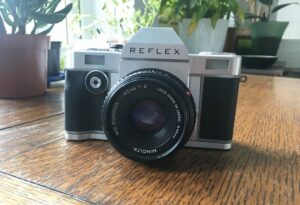
In 2020, the COVID-19 outbreak added additional complexities to the project, further increasing doubts of any hope that the Reflex would ever see the light of day. Backers had demanded refunds, the creators were accused of not caring, and as far as the photographic world was concerned, the whole Reflex project was considered a bust. In August 2021, a public Zoom call with the company’s creator was scheduled, in which solicitations for a new partner were proposed, but no real concrete promises were made of a working camera. A follow-up post, summarizing the meeting was posted on August 29, 2021, which remains the most recent update as of 2025.
What Went Wrong?
Sometimes more is less. You don’t need me to tell you that the Reflex was an ambitious camera. Not only for things like the I-plate interchangeable mount system, or the built in Arduino computer with smartphone connectivity, but that building any camera in 2018 with an all new shutter and technologies on par with a modern camera, is incredibly difficult to do.
There is a reason why big companies like Nikon, Canon, Olympus, and many others stopped making film cameras, it was no longer financially viable to do so. So for a brand new company with no history in manufacturing to promise something with this range of features, it wasn’t a surprise to anyone when the project encountered problem after problem with the actual construction of the camera. A lack of a usable shutter, an overly ambitious feature set, and a world pandemic was the trifecta that killed the Reflex. It is a shame too, because the camera was pretty cool looking, and I can’t help but wonder if perhaps a less ambitious camera might have had a better chance.
Nana Camera
So far in this article, I’ve covered two cameras which never made it into consumer’s hands. It certainly makes sense to consider a crowdfunding campaign a failure if nothing ever comes of it, but what about projects who actually made it to those who backed it, but then are later disappointed? (Yashica digiFilm camera Y35, I’m looking at you!)
The story of the FilmNeverDie Nana started in late 2023 when the Melbourne, Australia based company announced a new premium point and shoot camera called the Nana. FilmNeverDie started in 2011, originally as a reseller of Polaroid film, but eventually expanded into a retail store with a full service lab, photography workshops and their own line of rebranded film. The company even had their own camera, a previously available Niji camera which was a clone of another camera called the Dubblefilm Show.
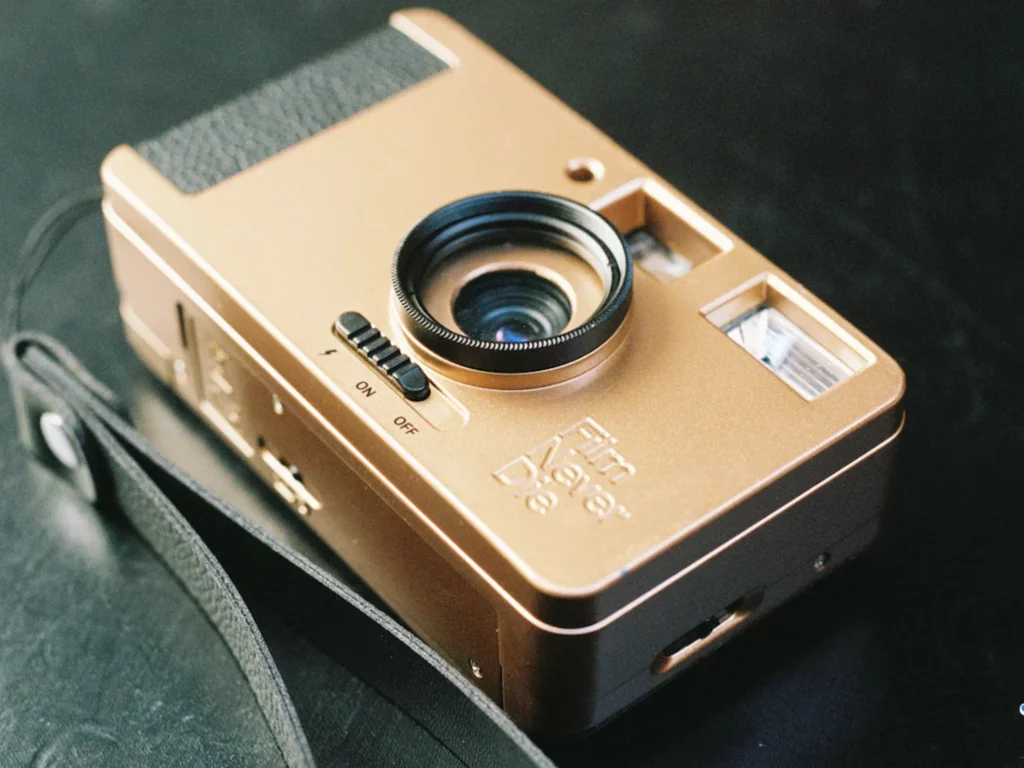 But the newly announced Nana camera was initially promised to be a premium full frame camera with a metal body, built-in flash, upgraded lens, motor drive, and dual zone focus system. With premium point and shoots like the Olympus Stylus Epic fetching prices in the multiples of hundreds of dollars, there certainly was an appetite for something in this class, and the Nana seemed like it might be that camera.
But the newly announced Nana camera was initially promised to be a premium full frame camera with a metal body, built-in flash, upgraded lens, motor drive, and dual zone focus system. With premium point and shoots like the Olympus Stylus Epic fetching prices in the multiples of hundreds of dollars, there certainly was an appetite for something in this class, and the Nana seemed like it might be that camera.
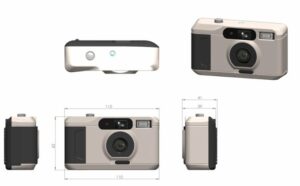
The initial announcement was followed up by a Kickstarter campaign in May 2024 which was quickly funded 10 days after the campaign launched. In that campaign, the Nana was described as “a simple-to-use, quality, affordable point-and-shoot film camera that looks as good as the images it captures.” Early concept drawings of the camera showed an attractive champagne and black body, which FilmNeverDie claimed had styling inspired by the Contax T2.
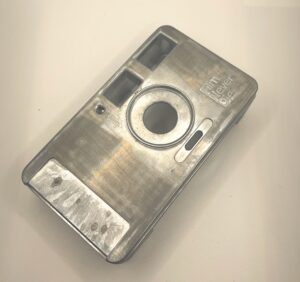
The Kickstarter confirmed the initial promises of a motorized film transport and improved lens (although with no technical specs) but by this point, the dual zone focus system was removed, replaced by a threaded focus ring to which closeup filters could be attached.
For those who got in early, they could score a finished camera at the early-bird price of AUD$225 which was considerably less than the estimated AUD$359 to 399 retail price. These prices when adjusted to 2024 US dollars put it at about $145 for the early-bird price and $230 to $255 respectively. Certainly cheaper than a Contax T2, but still more expensive than other simple cameras like the earlier Niji camera or the Kodak Ektar H35 half frame camera. People were excited. If the camera came delivered as promised in a fancy metal body with high quality lens, in body flash, easy exposure operation and motorized film transport, it should be a smashing success!
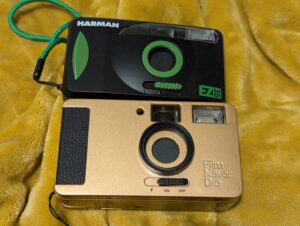
As news of the camera being funded spread through the film community, several people expressed concern with FilmNeverDie’s claim that this was a new camera. In fact, looking at the specs and early images of the camera, it started to appear that the Nana wasn’t a new camera at all, but rather, was a reskinned copy of the Harman EZ35 and a cheap camera sold on Alibaba called the MF301. Both the Harman and Alibaba cameras had nearly identical controls, an in body flash, an identical 31mm f/11 single element lens, and motorized film transport. The only obvious difference was the lack of the metal face plate and filter ring.
Japan Camera Hunter’s Bellamy Hunt was the most prominent critic of the Nana, but other sites voiced their concerns too including Alan Duncan from Canny Cameras who wrote several lengthy articles about it.
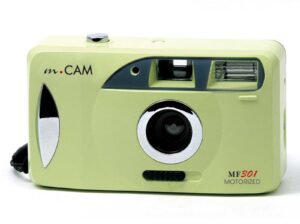
Whether or not the Nana was simply a badge engineered version of a cheap plastic Chinese camera was still up for debate, but thankfully the world wouldn’t have to wait long as finished copies of the camera made it out to backers hands later in 2024. In November 2024, Canny Cameras wrote another article, this time comparing the FilmNeverDie Nana to the previous mentioned Harmon EZ35. Side by side, the Nana definitely had a more premium look to it, but the metal body was limited to just the front plate which also extends to the top plate and parts of the sides. The internal film compartment, rear door, and battery door are all plastic. Side by side, the Nana and Harman cameras look identical. Functionally, the only difference was a filter ring that was grafted to the front of the Nana, which is absent on the Harman and other iterations of this same camera.
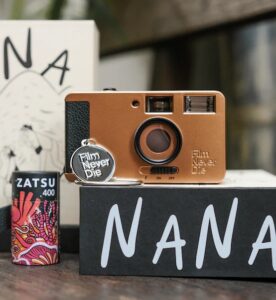
But what about the lens? FilmNeverDie claimed the 31mm single element optic was of a new design which promised superior results to other plastic point and shoot cameras, but early sample images were of mixed quality. Even if the Nana’s lens was made with improved precision, there is a limit to what a meniscus lens can do. No amount of computer aided optical design will ever made a one element lens look like a multiple element lens.
To FilmNeverDie’s credit, they promised a premium 35mm point and shoot with an in body flash, motorized film transport, filter ring, and a 31mm f/11 lens, and that’s what they delivered. In Alan Duncan’s review, he praised the packaging, saying it was nice, and that the camera came with a leather-ish strap and a single roll of film.
The biggest problem was the price. With a retail price well over USD$200, the FilmNeverDie Nana was more than four times more expensive than the Harman EZ35’s $50 retail price (as I write this in July 2025, I see it on sale at many places for $40. The Alibaba version of the camera can be bought for $30, with bulk options even less. Certainly those cameras don’t have the premium metal finish, filter ring, leather-ish strap, and fancy packaging, but is that worth more than quadruple the price?
Today, the Nana is still available to buy new. The price has come down a bit to USD$230, so I guess that’s something, but I can’t imagine this thing is a big seller, and for the most part, has been mostly forgotten by the film community.
What Went Wrong?
FilmNeverDie didn’t lie. Everything they claimed the Nana to be, it technically was. In my eyes, their fatal flaw was that they withheld information about what the camera actually was. Reading their 2023 pre-announcement and the May Kickstarter page, the descriptions of the camera consistently claim this to be a new “next generation” design. Repeated use of the word “premium” and comparisons to an actual premium camera like the Contax T2 intentionally played on people’s excitement suggesting a camera far more capable than it was.
I don’t know what it costs to machine a metal front plate, put a filter ring on a camera, and make some cool packaging, but if FilmNeverDie wanted to make a camera that improved on an existing design that cost a few extra dollars, I don’t think anyone would have minded, but to suggest this was anywhere to the level of a premium point and shoot with a price more four times that of other, nearly identical cameras, was pretty misleading.
But they didn’t lie.
Yashica FX-D: Film Simulation Camera
We know the fate of every other camera in this article as they either made it to production, or the production ended with no plans to start up again. But what about future crowdfunded cameras that we don’t yet know the fate of?
For the most recent camera discussed in this article, we go back to Yashica, or more specifically, 100 Enterprises International Group Company Limited in Hong Kong, China who own the trademark to the Yashica brand. No longer a Japanese maker of of fine TLR, SLR and rangefinder cameras, the Yashica brand disappeared in the 1990s when they were owned by Kyocera.
The Yashica brand re-appeared in 2017 and since then it has been applied to cheap digital cameras, rebadged 35mm film, and even the I’m Back film to digital conversion thingie.
In May 2025, a Kickstarter campaign launched for an all new Yashica digital camera called the Yashica FX-D, which claimed to be the first “film simulation camera”. This wording is strangely similar to how the company marketed their earlier Yashica digiFilm camera Y35 in 2017. Unlike that camera, the new FX-D had a strong SLR-like styling and appeared to be a much more ambitious project.

The initial announcement caused some confusion whether this was a film camera or some type of hybrid film or digital camera, but it quickly became clear that this was a fixed lens digital only camera, with classic film-like styling and a design which harkens back to the film era.
My initial reaction upon reading this camera’s announcement as I thought it was quite bold of the company to dip back into the pool again with another digital camera with strong connections to Yashica’s film history. In fact, there actually used to be a real Yashica camera called the Yashica FX-D which was a regular 35mm SLR released in 1980.
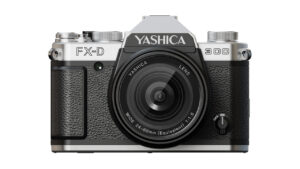
The initial Kickstarter campaign began on May 27, 2025, and was fully funded in 10 minutes. I am unsure of what their financial goal was, but whatever it was, clearly, the announcement had struck a nerve with people as there was a tremendous level of excitement for it. My thought was either, Yashica (I’ll keep referring to the company as ‘Yashica’ even though that’s not their real name) either did a great job with this new camera, or a large number of people seem to have forgotten or forgiven the original digiFilm Y35 camera from 2017.
As they did last time, Yashica intentionally blurs the line between digital and film claiming the FX-D has Analog and Digital Modes. Marketing for the camera shows six different film simulation modes, strangely including images of 35mm film cassettes with the names of each of the six modes on them. The camera itself has a film advance lever, just like a film camera should have, requiring you to “advance” the camera before each shot. It is not clear to me whether this is a feature that can be turned on and off, but based off the earlier Yashica digiFilm Y35 camera, it likely is a requirement.
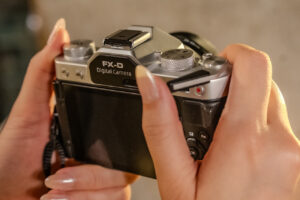
Shortly after the announcement of the FX-D, it was revealed that two versions of the camera would be made called the Model 100 and Model 300. Major differences between the two are in the sensor and price. The cheaper Model 100 comes with a 13.0 MP 1/3.06″ CMOS sensor, typically found in smart devices and security cameras, and an optical zoom 25 – 75mm equivalent f/1.6 – 2.8 lens. The Model 300 has a larger 50MP 1/1.56″ sensor of unknown manufacture and a non-optical zoom 24 – 30mm f/1.8 lens. For those of you who aren’t familiar with sensor sizes both of these sensors are very small. With crop factors in the range of 4-6x from full frame 35mm, the amount of light these sensors would be able to capture would be significantly less than other small sensor APS-C and micro 4/3rds systems. All versions of the camera would have a swiveling rear 2.8″ LCD with built in wi-fi to be used for smartphone connectivity but without any type of eye-level viewfinder.
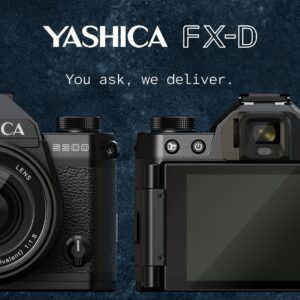
As feedback poured in about the camera, specifications changed and a third model, confusingly called the Model S300 (why not Model 400 or 500?) added an EVF and an all black body. In addition, the option to write RAW images was later added to the specifications of all three models based on consumer feedback.
Launch special and final retail prices for all three models are for the Model 100: $239 / $359, Model 300: $339 / $549, and Model S300: $459 / $679. As always, the launch special prices expired as the project became funded, but also like other crowdfunded cameras, once retail versions hit the market, it is unlikely that the retail prices will be what people pay.
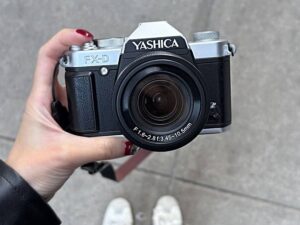
As I write this in July 2025, none of these cameras have hit the hands of consumers, although a great deal of still photos and videos of the camera in action have hit the market. Without any real world samples to judge, I’ll at least give credit to Yashica that they are doing a really nice job of promoting this camera. The amount of information both in the Kickstarter’s Campaign page and in other social media posts they’ve made, is impressive. Unlike the ambition of the Reflex SLR mentioned earlier in this article, it seems very unlikely this camera will turn out to be vaporware and never hit the market.
How exactly the cameras will be received once they hit the hands of consumers is unclear. I feel like we’re back in 2018, after the Yashica digiFilm camera Y35 was funded but before the camera ever hit the market. The biggest flaws of that camera were its incredibly poor and cheap feeling build quality, and less than stellar image quality. Looking at images of the Yashica FX-D, the camera appears to be a step or two above the earlier Yashica camera in build quality, but exactly how much is anyone’s guess. Will this camera also have metal plates inside its chassis to artificially boost its weight and will the film advance lever and tactile controls feel like they could break off at any moment? No one yet knows!
While the promise and features of the Yashica FX-D are exciting to read about, it is important to remember that expectations need to be kept in check. This is an ambitious camera made by a company without a track record of delivering ambitious cameras. The retail prices of these cameras are within the range of much better cameras like the Nikon Z30, Canon EOS R100, and Panasonic LUMIX FZ80D. And with the extremely tiny sensors on these Yashica camera, how much worse will the images look to cameras in the same price range with physically larger sensors?
What Went Wrong?
Since none of the Yashica FX-D models have officially been released, no one knows exactly how this camera will turn out, so of course I can’t say that anything has gone wrong. I’ve already acknowledged that the camera looks impressive and Yashica’s marketing team has done a really good job of sharing and promoting the camera. If I have to make a guess though, I feel they are making the same mistake they did with the Yashica digiFilm camera Y35, which is that by using the Yashica name and giving it a look which is reminiscent of a classic film camera, they are intentionally setting themselves up for comparisons with those original cameras. Collectors and camera enthusiasts are difficult to please people and the more this camera tugs on nostalgia, the more their emotions will factor into their opinions of this camera.
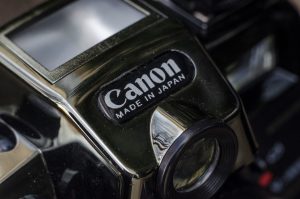
Collectors and film enthusiasts such as myself have a high level of respect for brands like Yashica, who in their prime years, made excellent and highly regarded cameras. To the large groups of younger people today who are likely to be interested in a digital camera with a “film-like” experience, they probably don’t care about the name. To them, whether this camera is called the Yashica FX-D, or if it has a name like “Chinocam 5000″, they’re not going to care, but by appealing to those who do care about the name, unfair comparisons will always be made. In my opinion, tapping into people’s nostalgia for a product which has the potential to survive without it, simply adds fuel to large amounts of criticism that many people are almost certainly going to throw at it.
I also have serious concerns about the sensors used in these cameras. While there is enough evidence out there that proves you don’t need a 24mm x 36mm full frame sensor to get good images, that the larger sensor in the FX-D 300 and S300 models is an unknown 1/1.56” sensor which is smaller than the main cameras in both the iPhone 16 Pro and Samsung Galaxy US25 Ultras, suggests that image quality is still subpar to the latest smartphones. While sensor size does not tell the whole story of image quality, it certainly is a major factor and when you look at the escalating prices for the newer Model 300 and S300 cameras, you are encroaching on micro 4/3 and APS-C cameras made by proven companies.

